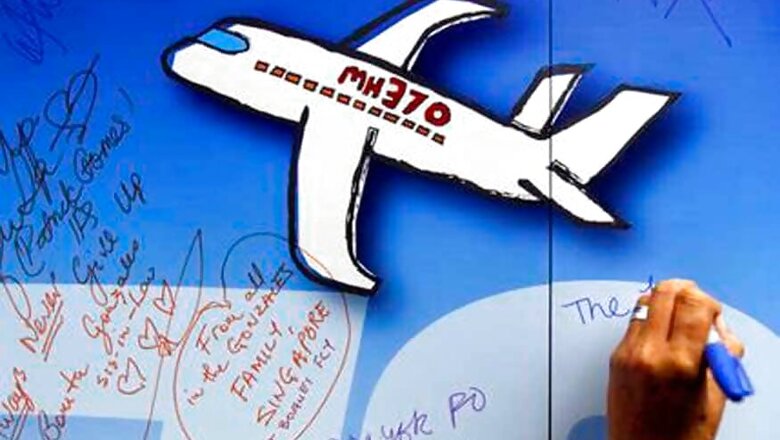
views
Sydney: After nearly three years, the hunt for Malaysia Airlines Flight 370 ended in futility and frustration Tuesday, as crews completed their deep-sea search of a desolate stretch of the Indian Ocean without finding a trace of the plane.
The Joint Agency Coordination Center in Australia, which has helped lead the $160 million hunt for the Boeing 777 in remote waters west of Australia, said the search had officially been suspended after crews finished their fruitless sweep of the 120,000-square kilometer (46,000-square mile) search zone.
"Despite every effort using the best science available, cutting-edge technology, as well as modelling and advice from highly skilled professionals who are the best in their field, unfortunately, the search has not been able to locate the aircraft," the agency said in a statement. "Accordingly, the underwater search for MH370 has been suspended."
Officials investigating the plane's disappearance have recommended search crews head north to a new area identified in a recent analysis as a possible crash site. But the Australian government has already nixed that idea.
Last year, Australia, Malaysia and China — which have each helped fund the search — agreed that the hunt would be suspended once the search zone was exhausted unless new evidence emerges that pinpoints the plane's specific location. Since no technology currently exists that can tell investigators exactly where the plane is, that effectively means the most expensive, complex search in aviation history is over.
Timeline of the 3-year search for missing Malaysia plane
March 8, 2014: Air traffic control loses contact with the plane 40 minutes into a flight from Kuala Lumpur, Malaysia, to Beijing. An air and sea search begins four hours later in the Gulf of Thailand and the South China Sea.
March 15, 2014: Malaysian Prime Minister Najib Razak announces that Flight 370 was tracked by military radar doubling back across the Strait of Malacca and was sending satellite signals seven and a half hours after takeoff. The aircraft then flew either northwest toward central Asia as far as Kazakhstan or southwest over the southern Indian Ocean. Signal analysis quickly ruled out the northern flight path.
April 8, 2014: An Australian ship towing a U.S. Navy listening device hears two signals consistent with Flight 370's flight recorders west of Australia. Submerged a month, the recorders are near the end of their battery lives. "I'm now optimistic that we will find the aircraft, or what is left of the aircraft, in the not-too-distant future," search coordinator Angus Houston says. When the initial sonar search yields nothing, it's expanded to an area of 60,000 square kilometers (23,000 square miles).
April 28, 2014: The air search ends after failing to see a single piece of debris in 4.6 million square kilometers (1.8 million square miles) of ocean.
May 28, 2014: The underwater survey near where the acoustic signals were detected ends, with investigators concluding the area is not the final resting place of Flight 370 and they may never know the signals' origins.
June 26, 2014: Officials announce that Flight 370 most likely crashed southwest of the most recently suspected crash site, about 1,800 kilometers (1,100 miles) off Australia's west coast. The new 60,000-square kilometer (23,000-square mile) search area falls within the waters already searched by air, to no avail.
August 28, 2014: The search area is refined south after analysis of a failed attempted satellite phone call to Flight 370 suggests the plane turned south earlier than previously thought.
January 29, 2015: Malaysia formally declares Flight 370 an accident and says all 239 people on board are presumed dead, upsetting families but letting them obtain death certificates and start legal claims.
March 8, 2015: Australian Prime Minister Tony Abbott doubles the area of the search to 120,000 square kilometers (46,000 square miles). Still, only 40 percent of the original zone has been searched. "It can't go on forever, but as long as there are reasonable leads, the search will go on," Abbott said. "We are reasonably confident of finding the plane."
March 10, 2015: The sonar search discovers the wreck of a 19th century cargo ship nearly 4 kilometers (2.5 miles) below the surface.
July 29, 2015: A wing part known as a flaperon found on Reunion Island, east of Madagascar, is confirmed as the first piece of the Boeing 777 to be recovered. More than 20 pieces certainly or highly likely to be parts of Flight 370 have since been found on coastlines throughout the Indian Ocean.
December 19, 2015: The sonar search discovers a second shipwreck from the 19th century.
July 28, 2016: Australian officials confirm that data recovered from a home flight simulator owned by Flight 370 captain Zaharie Ahmad Shah showed that someone had used the device to plot a course to the southern Indian Ocean, bolstering speculation that he stole the plane in a premeditated plot.
December 20, 2016: The Australian Transport Safety Bureau releases a report that says Flight 370 is unlikely to be in the 120,000 square kilometers (46,000 square miles) that has been almost completely searched and is more likely in a 25,000-square kilometer (9,700-square mile) area immediately to the north.




















Comments
0 comment